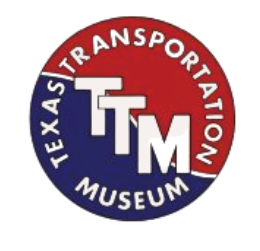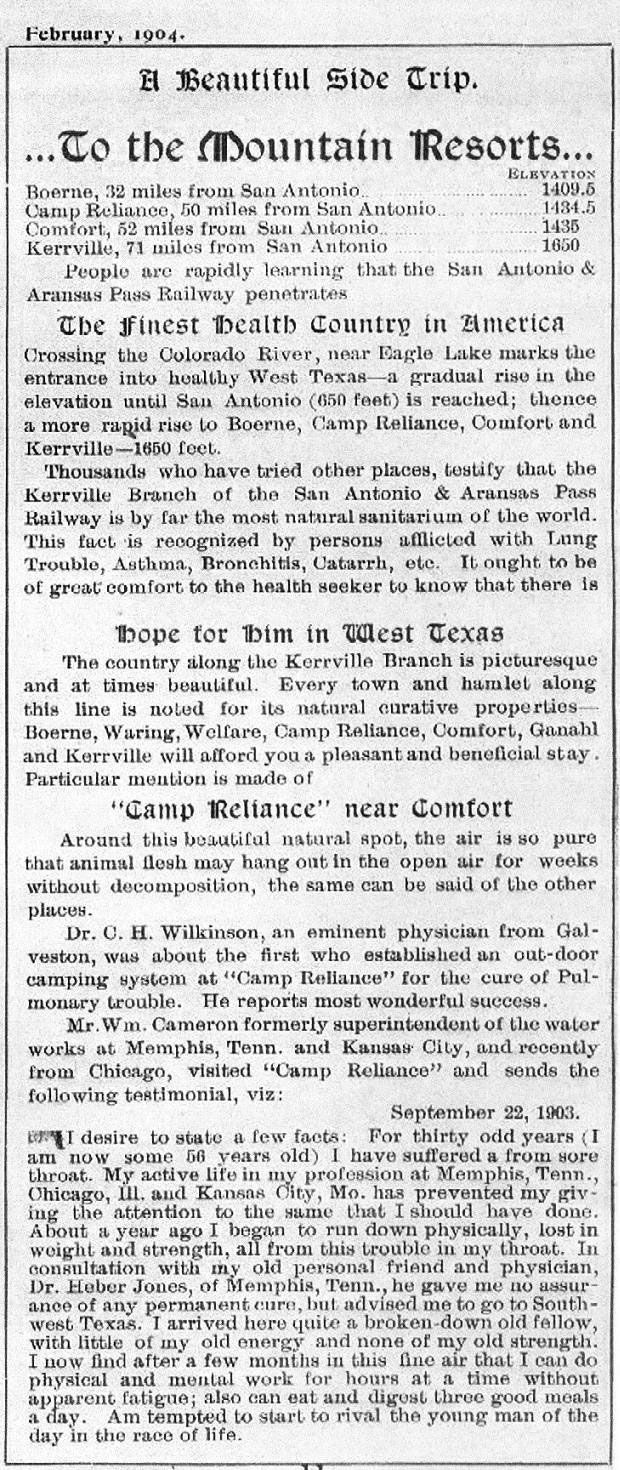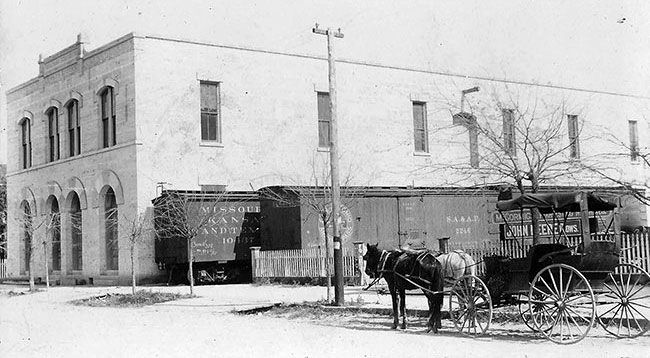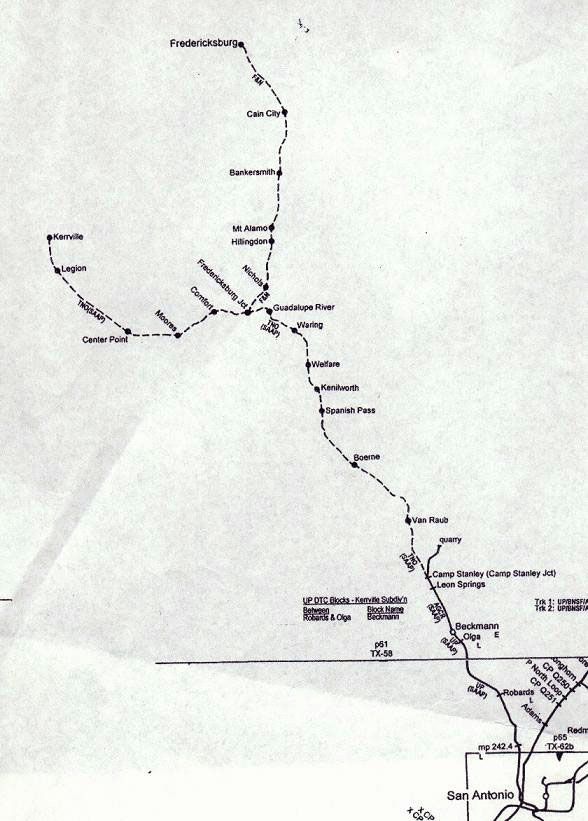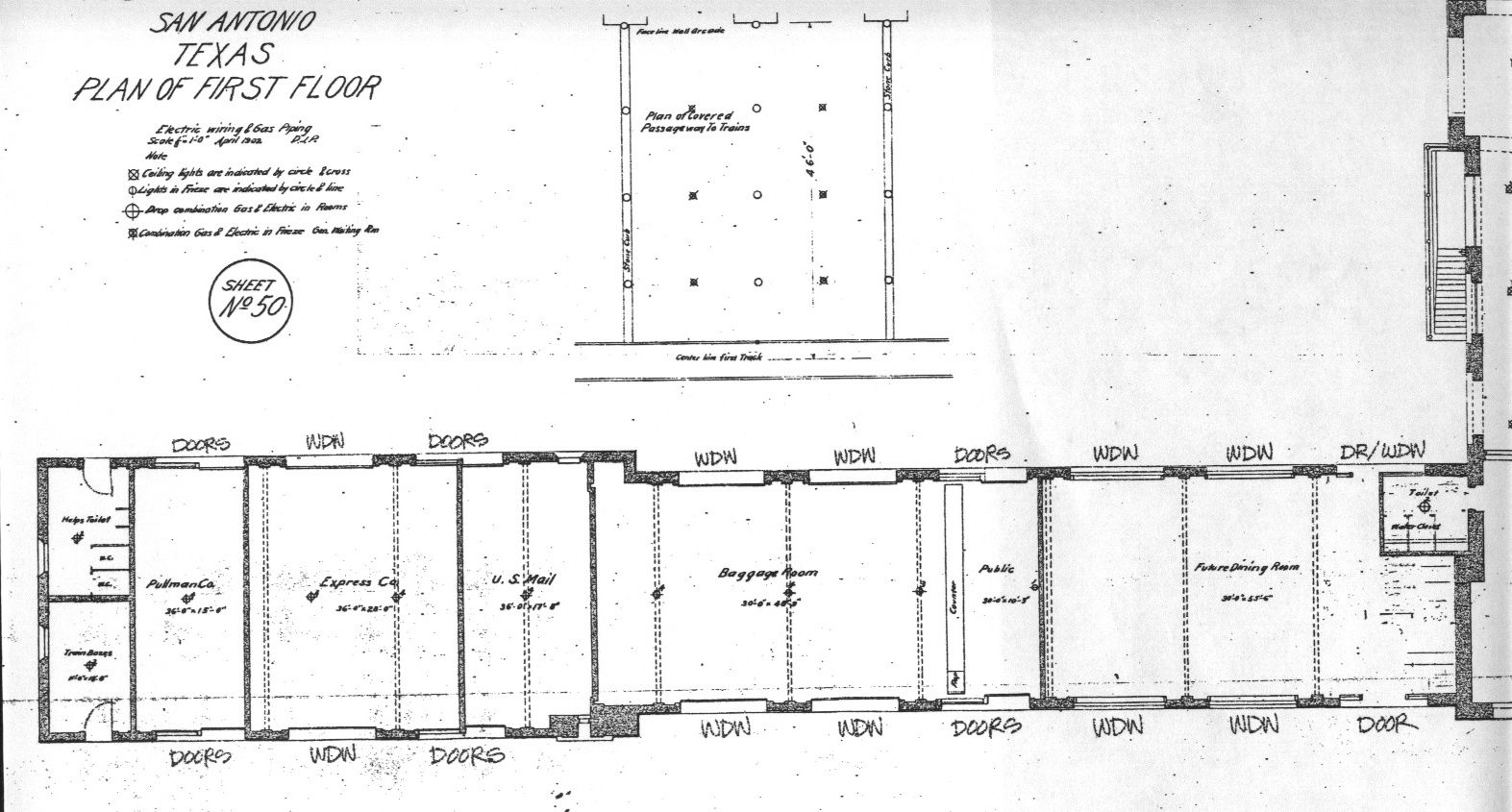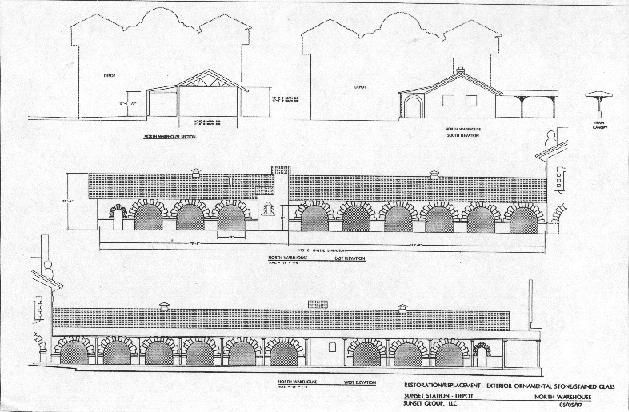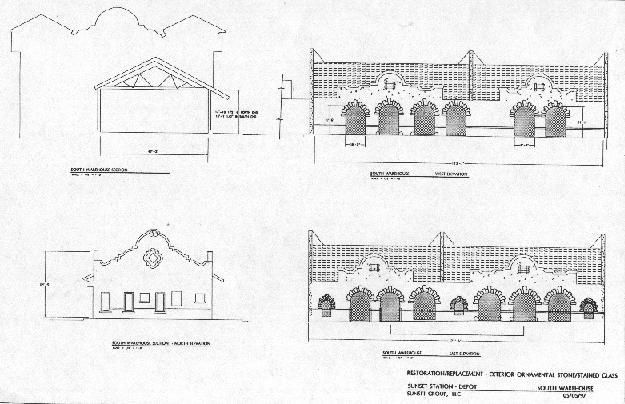Kerrville and the Railroad
The museum is indebted for the assistance received for this page. Our thanks to Rails, A Cafe at the Depot, who shared the large quantity of information they had gathered as the Kerrville depot was being so lovingly restored. We are also grateful to The Hill Country Museum, who went out of their way to provide more pictures and information. The staff of the Kerr Regional History Center provided invaluable guidance and material. Thanks also to the Kerrville Daily Times who provided some key information and images. Certain individuals will be mentioned in the text but it would be remiss of us not to mention the generosity of Joe Herring, of The Herring Printing Company whose encyclopedic knowledge of Kerrville and Kerr County pointed us in several interesting directions.
Thanks also to Dave Wallace, the founding member of the Texas Transportation Museum. Not only did he manage to catch a ride on the last freight train into and out of Kerrville in 1970, he has a home movie of the trip AND a file containing copies of the documents created by the Southern Pacific when they were applying to the ICC, the Interstate Commerce Commission for permission to abandon the line north of Camp Stanley.
At 11:45 AM on October 6, 1887, the first train arrived in Kerrville. On board the six Pullmans were 502 passengers, 200 from San Antonio, 131 from Boerne, 141 from Comfort and 30 from Center Point. Altogether this was 200 more people than actually lived in Kerrville. It was a banner day for the town, with parades and speeches. At the center of it all was Captain Charles Schreiner, whose visionary plans for the community were being realized in front of his eyes. He had been a significant part of the effort to raise the $180,000.00 demanded by the railroad, the San Antonio and Aransas Pass, before it began work just over a year earlier, August 26, 1886. With the 71 mile line complete, Kerrville's future growth and expansion were assured.
Kerrville, originally Kerrsville, had been established in 1856 when Kerr County was created. The nearby town of Comfort, which ended up in Kendall County in 1862, was the bigger community and was briefly named the county seat. Even Center Point, originally named Zanzensberg, half way between Comfort and Kerrville, not to mention Fredericksburg and Bandera, had a larger population, but the ambitions of the people of Kerrville were stronger and well founded. The arrival of the railroad brought prosperity all along its line through the Hill Country. It used to take two days to get to San Antonio from Kerrville, with an overnight stay in Boerne. Returning in a fully laden wagon might take even longer and, during inclement weather, it took longer still. The railroad brought in people and materials and allowed the cedar shingle businesses, which had been the original reason for the community's foundation, to expand. Soon sheep and goats were successfully introduced and before long Kerr County had become one of the premier mohair producing regions in the nation..
Somewhat less than 10% of Kerr county's land is suitable for agriculture, and ranching, therefore, has always predominated the economy. But the region had other attractions, not the least of which was its "Sweet Air." Tourism began almost immediately with the arrival of the railroad. Various denominations created youth camps in the area. Uriah Lott, the general manager of the SA & AP, had a very soft spot for orphans and often put on a special car at the rear of trains to Kerrville especially for them, paying for their food and drink from his own pocket. The population of the entire county was only 2,108 in 1880. By 1890 it had more than doubled to 4,462. By 1900, the population of Kerrville alone stood at 2,353.
The military also had a keen interest in the area. As weapons grew more powerful, firing them within the city limits of San Antonio became impossible. Before Camp Stanley, originally named Camp Funston, was formally acquired by the army in 1917, additional ranges existed in the Hill Country. There was a rifle range on the depot side of the Guadalupe River at Center Point on land owned by the Ganahl family. (This is why you see Ganahl listed in early timetables.) An artillery range was operated near Kerrville. It's precise location is not known but it seems reasonable to assume it was on the same site used by the entire 2nd Division in 1926 between Kerrville and Ingram. In the only known photograph of this event, there are multiple aircraft set out along a large parade ground and the site is described as the Louis Schreiner Field. Development has encroached on the site today and it its most visible occupant is Wal-Mart. Following World War One, a site was needed for a large veteran's hospital. Kerrville was selected and the Legion Hospital opened on July 1, 1923. (If you look at the 1940 timetable, you can see a stop listed as Legion three miles south of Kerrville.) The original hospital was replaced after World War Two, in 1947, and has been in constant use ever since.
The interests of Captain Schreiner were diverse. He created the famous Y.O. ranch near Kerrville plus a large mercantile operation that still bears his name. He established a number of wool and mohair warehouses. One was close to his store on Water Street. A spur rail line ran to this warehouse and stopped at the rear of the store nearby as well. Another even larger warehouse was later built on McFarland Drive. It too had a spur line. Although this "Wool House" is long gone, a remnant of the tracks is said to remain visible in the area. Schreiner's interest in the railroad was intense. In a newspaper clipping from the early 1900s he reportedly timed the train over the twenty miles between Comfort and Boerne and recorded the 19 minute duration, or 63 MPH speed, with some satisfaction.
Passenger travel to Kerrville was brisk from the 1890s up to the 1920s. To enable additional service while keeping costs down, the Southern Pacific, which all but fully acquired the SA & AP in 1892, added motor car service to the regularly scheduled train, which may have been a mixed freight. The motor car left Kerrville at 6:50 AM, while a train pulled by a steam locomotive left in the opposite direction from San Antonio at 8:37 AM. The journey took around three hours. After turning around, the train departed Kerrville at 2:00 PM while the motorcar set back out for the Hill Country at 4:00 PM. In 1913 the passenger section of the original depot in Kerrville burned down but the freight room was saved. In 1915 a new masonry passenger depot was opened four blocks east of the original depot. At the time its given address was 430 Quinlan. Competition from private cars and the Kerrville bus company, one of the most successful in the region, led to a slow diminution of passenger rail service. First it was cut back to one train a day in each direction. By 1940 it was just a few cars at the rear of the daily freight train. The war years saw an increase in rider ship but this rapidly subsided and all regularly scheduled passenger service had ended by 1947. Occasional special trains continued off and on until the last one was recorded in 1954..
The railroad continued to use the passenger depot as the freight agents office. But as Highway 27 to Comfort and US 87 into San Antonio were improved, the costs and facility of using increasing larger trucks to move freight gave the agents, a Mr. H. Holchak in 1956 and Mr. W. Nelson in 1960, less and less to do. When the line was under construction a plan of sorts had existed to continue on towards San Angelo, but the costs of getting to Kerrville had far exceeded expectations and, with few if any communities of any size along the way to provide funding, the line did not get any further. When the Southern Pacific was finally allowed to fully acquire the San Antonio and Aransas Pass in 1925, these plans were resurrected and preparatory grading work was actually started before the Great Depression caused the idea to fade to nothing once more. J.H. Allhands records that Uriah Lott himself, who died in 1915, was somewhat bitter about the Hill Country line, blaming its high costs and low returns as a contributory factor in the S.A. & A.P.'s failure in 1890.
By 1964, the S.P. was only sending six trains a week along the Hill Country line. Of these three turned around at Camp Stanley or the small quarry just north of it, and only three as went as far as Kerrville. By 1967, this had been reduced to just two to Kerrville. In 1969, H.J. McKenzie, a Southern Pacific Vice-President, submitted the necessary papers to the Interstate Commerce Commission for the abandonment of the line between Camp Stanley and Kerrville, on the basis that it " . . . is being operated at a loss and for which there is no reasonably foreseeable prospect of profitable operation in the future." The line is described as being in poor condition with a net salvable value of $238,118.00. Citing competition from the trucking industry, the companies listed as serving the area were the Basse Truck Line, Curry Motor Freight Lines, Red Arrow Freight Lines and the S.P.'s own trucking division. What is also interesting is that in 1969, IH 10 still stopped at Comfort. To this point it has been developed from US 87, which was built to Fredericksburg. The interstate west of Comfort was a brand new route and still under construction. The only road to Kerrville was HWY 27, which shadowed the tracks from Comfort, through Center Point. In the S.P.'s own report, it is described as merely a two lane road.
In 1969 the principle remaining railroad customers were described as feed and lumber dealers, a peanut producer, a beer distributor, a mohair producer and a small mineral company. Just two years earlier the biggest source of railroad freight was gypsum. Some 220 cars were moved, a combined weight of 16,156 tons. By 1969, this had fallen to zero. The largest remaining product in 1969 was cattle feed, 17 cars, 402 tons. Again just two years earlier, the railroad had moved 133 cars, 3,845 tons.
The decline is best reflected in the gross numbers:
YEAR CARS TONS
1967 553 27,091
1968 459 19,448
1969 50 1,765
The numbers spoke for themselves. The very last train, carrying gravel, was run om May 15, 1970. On board the locomotive was a founding member of the Texas Transportation Museum, Dave Wallace, who was also running several railroad related businesses at the time, including the acquisition and disposition of the many unwanted passenger cars that had flooded the market when AMTRAK took over what remained of the national passenger network. In Kerrville, the remaining section of the original 1887 depot, at the corner of Schreiner and Lemos, had been demolished several years earlier. The Southern Pacific's petition to abandon the line north of Camp Stanley was approved on February 2, 1971. The tracks were pulled up north of that point and within Kerrville, several wide streets were created, including North and Aransas. You can hardly tell a railroad had used the route for over 80 years. There are no tell tale warehouses or similar businesses anywhere in evidence. The address of the passenger depot changed from 420 Quinlan to 615 Schreiner as a road replaced the railroad right of way. As the tracks became a memory the building saw a number of tenants, all in the food business. After being a bar-b-que joint for some time, it became a pizza parlor. It was put up for sale again in the late 1990s and purchased by its current owners who decided a total renovation would be required. This was so well done that they won the 2004 Best Rehabilitation Award from the Texas Downtown Association. The building now houses RAILS, A CAFE AT THE DEPOT which is chalking up rave reviews itself for its food quality and friendly service.
The railroad is long gone from the Hill Country but it has left a deep legacy of service, one that helped firmly establish towns struggling to survive in what was quite a harsh environment. With a modern transportation link, communities along the 71 mile route became not only viable but prosperous. Journeys that took days now took hours. The transportation of freight in quantities unimaginable by ox pulled wagons over unfinished roads allowed several lucrative operations, such as ranching, mining and wool production to provide occupations to many new residents to what is one of the most charming parts of Texas. This charm, not to mention the advertising efforts of the Southern Pacific, also brought many visitors and many decided to stay. One of these was the famous songwriter, Jimmie Rodgers, who wrote his big hit, "Waiting For A Train," in the Kerrville depot in 1928 while, what else, waiting for train. Kerrville has grown to over 20,000 residents today. It has a sizable airport catering to wealthier residents who can afford to fly into the community. The rails are gone, replaced by an interstate, but its memory lingers for those who care to try to find it.
Kerrville Station in 2017
Transportation Museum
CONTACT US TODAY
Phone:
210-490-3554 (Only on Weekends)
Email:
info@txtm.org
Physical Address
11731 Wetmore Rd.
San Antonio TX 78247
Please Contact Us for Our Mailing Address
All Rights Reserved | Texas Transportation Museum
